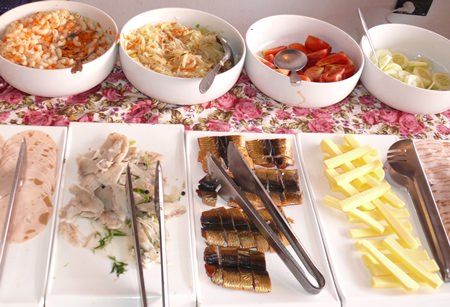
The advent of the smartphone has not done much for the art of photography. Having a phone that can take and store pictures has not developed any latent artistic abilities in the holder of said electronic equipment as far as I can see.
Even the briefest perusal of the social media will show that the artistic talent goes as far as taking a “selfie” (how I dislike that word) and then follow that up with a picture of what he or she ate. As if the world is hanging on his or her fork tangs. Personally I couldn’t care less what you ate, unless it was some culinary tour de force.
If you must show the world just what you had for your last supper (it would be if I could get hold of some of these social media freaks) I will give you some pointers to make it look as if this was a great plateful and not some collection of ingredients thrown onto a plate and tinged with green.
Let’s deal with the green pies first. Fluorescent lighting is the culprit. To the naked eye the lighting in the kitchen seems fine, but to the electronic receptors, the white balance is not correct, and hence the green.
To correct this is very easy. Use natural light to photograph food. Take the dishes outside, around 4.30 p.m. is best, and with the light coming across the food, take the shot. The colors will be natural and there will be some light and shadow to give depth to the photograph.
If you are going to add a bottle of wine to the shot, or make the wine a feature, you have just picked one of the most difficult items to successfully capture. To be able to photograph wine is one reason why food photographers can command such high fees.
Have you ever tried photographing champagne to put in your FB photos? Have you then noticed that there’s never enough bubbles to make it look sparkling. Fortunately, the champagne (or Prosecco or Method Champenoise) can be coaxed into producing as many bubbles as you might want. All you have to do is drop some sugar into the glass. Only a few crystals are enough to give the almost flat glass of champers that “just opened” fizz look to it. For a catalogue shot you also have to bring the light in from the back of the glass, as well as from the front. This takes two flash heads, or at least one head and a reflector, which is a little beyond your average “selfie” photographer.
While still on wines, if you try and shoot a bottle of red wine, it will come out thick dark maroon or even black. Amateurs who have tried photographing red wines will be nodding their heads in agreement. So what does the pro shooter do? Well he has a couple of courses of action. First is to dilute the red wine by about 50 percent and secondly place a silver foil reflector on the back of the bottle. You can light it from the front and the silver foil reflects the light back into the wine.
So what happens to the half bottle of red that was removed to dilute the wine? The photographer has it with dinner.
As far as how to take a better “selfie” is concerned, about all I can give you is to try and keep your arm out of the picture. The arm holding the camera being closer to the camera is exaggerated in size, so a “selfie” stick is much better. And if you are not happy with the result, don’t take the same one again and a again. The additional shots will look as bad as the first one. Move your body, move from where you were standing, and try and get better lighting. Turn the flash off, if you can, is a very good idea as you will get shadow to add more interest.
So even though I very rarely see good photographs in the social media, it is possible to get better images. Just try next time, rather than banging off 27 shots all the same, and all boring as well.
 |
 |
 |





